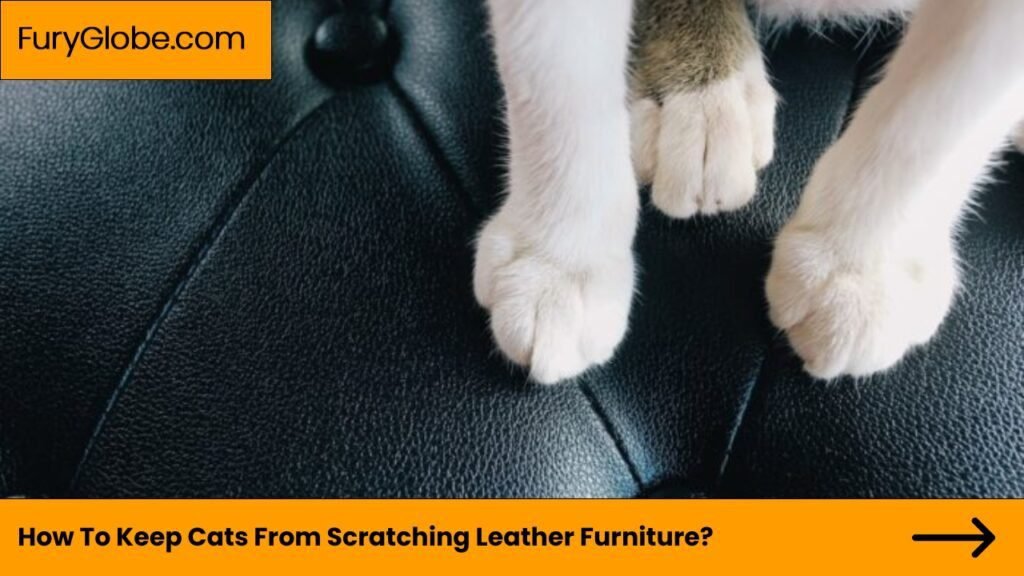How to keep cats from scratching leather furniture may seem challenging, but it’s essential for preserving your home’s decor and your sanity. Cats scratch as part of their natural behavior to sharpen their claws, stretch their muscles, and mark their territory, which unfortunately often targets beloved leather pieces. This not only damages the surface but can also lead to costly repairs or replacements if not addressed properly.
Read also: How To Get Urine Out Of Leather Furniture?
In this cat guide entitled “How to Prevent Cats from Scratching Leather Furniture”, we are going to give you seven very useful strategies that will help keep your feline friends from taking up your leather furniture as their personal scratching board. From finding the right scratching alternatives to understanding and modifying the behavior of your cat, this article will provide you with the information you need in order to protect your investments while preserving a harmonious living environment for you and your feline friend. Tune in to find out how slight interventions could significantly enhance the lifespan and appearance of your leather furniture.
Table of Contents
ToggleHow to Keep Cats from Scratching Leather Furniture: 7 Tips
Before discussing strategies that would help protect your leather furniture, it’s worth knowing the instinctual reasons why cats scratch. The first couple of reasons I’d want to pass on are that cats scratch because they need to sharpen their claws; it acts as a means of marking territory and body stretching. Touch and resistance of leather may make it an irresistible material for their scratching and digging activities. With this knowledge, the following tips are aimed at being not only helpful in discouraging your cats from scratching but also redirecting these natural behaviors into methods which will keep furniture intact with your feline happy. Let’s discuss some practical solutions.
Tip 1: Offer Various Scratching Alternatives
You should also offer your cat a few types of scratching posts and pads to take its scratching activity away from your leather furniture. Cats scratch not only to maintain the health of their paws but also to mark their area and stretch their muscles, so the needs must be appropriately met. You can start by providing different types of scratching posts, including vertical posts, horizontal boards, and angled pads. The material used can vary, including sisal and carpet, to corrugated cardboard, all of which, naturally, will have different textures and resistance than the cat likes to scratch.
The placement of these scratching posts is very important. Firstly, keep them near the leather furniture they currently target. This arrangement makes the posts more inviting than the furniture. Later, you can relocate these posts to more convenient places once your cat becomes habitual to use the posts. The post should be strong and tall enough to enable your cat to stretch while scratching since this is part and parcel of what cats do.
Tip 2: Apply Safe Scratch Deterrents


Apply safe scratch deterrents to keep your cats from damaging your leather furniture effectively.
There are many sprays and natural repellents you may use, and they can be citrus-based, menthol, or eucalyptus-based. These work because cats detest them but are harmless to cats and safe to apply on leather furniture. Apple cider vinegar mixed with water and essential oils makes up a homemade version of the deterrent. Spray this solution lightly over and around all furniture, especially those areas your cat likes to hang out.
There are also products available in stores that work well, which are specifically prepared to not be bad for pets or leather. These products should always be tested on an inconspicuous corner of the furniture to check that they will not damage the leather. This could require daily applications to remain effective.
Tip 3: Layer Protection with Physical Barriers
Couch covers, slipcovers, or plastic protectors offer a leather furniture cover that does nothing less than offer a physical shield. In addition to protection against scratches, these covers can also fit into the aesthetics of your decor if chosen appropriately. First, make sure to get snugly fitted covers and one that matches your interior design. Ensure it is tough enough yet easy to clean; preferably machine washable.
You can use simple home solutions like using the sheet or blanket over the sofa. Of course, it will temporarily change the look of your furniture, but it is a good deterrent against scratching when you’re not home to watch.
Tip 4: Take care of your cat’s claws regularly



Keep your cat’s claws trimmed regularly to reduce the critical harm that could be inflicted upon your leather furniture. Regular trimming of the cats’ claws keeps them relatively dull and may completely prevent them from having enough traction to do any significant destruction to hard materials. Use a veterinary-prescribed or high quality cat nail clipper and avoid cutting the quick as this can cause bleeding in your cat.
If this hurts your feelings, you could take your cat to the vet or a professional groomer who will teach you the proper way to do it. Maintenance also protects your furniture and will save your pet from suffering possible claw injuries.
Tip 5: Arrange Your Space Wisely
You can minimize cat scratching on leather furniture by strategically rearranging your space. Place scratching posts and interactive toys in places where your cat spends most of his time, directing its attention to these objects away from the pieces of leather furniture. Consider the layout of your room and how you set your furniture. You can designate an area for your cat as an alternative place where he can scratch and scratch without damaging the leather items.
You can also create “no-go” zones by putting scat mats or double-sided tape on the furniture when you are away from your cat. These deterrents will give your feline an uncomfortable, non-harmful feeling, thus discouraging it from re-entering those areas.
Lesson 6: Positive Reinforcement for Teaching Your Cat



Positive reinforcement can be a really powerful tool in training your cat to avoid scratching at the leather furniture. Any time your cat uses the scratching post instead of the furniture, you immediately reward him or her with some treat, the petting session, or some amount of playtime. The reward will help the cat associate using their scratching posts with a good outcome.
The heart of reinforcement is consistency. Any patient and persistent cat owner will benefit from being patient when it comes to their cat’s behavior, avoiding letting a cat cry or even punishing it for scratching the furniture because it will get stressed and confused. On the other hand, try to guide them towards scratching the post when they begin to scratch the furniture.
Tip 7: Go to a Behavior Specialist
If your cat persists on scratching the leather furniture even after you do your best to stop them, then it is about time you see a behavior specialist. He or she comes and assesses the environment of your cat, as well as his general health, to properly advice on how he should be kept free from undesirable scratching.
Behavior experts can also advise you on environmental modifications, add-on training techniques, and sometimes prescribe a pheromone diffuser or supplements that might help to calm your cat and lessen the stress-related behavior of scratching.
With these specified tips on how to keep your leather furniture safe from scratches and cat scratching, you will keep your leather furniture safe, yet your cat happy and healthy.
Conclusion
Through implementing the seven strategic tips outlined in this guide, you can effectively protect your leather furniture from your cat’s natural scratching instincts while fostering a happy and enriching environment for your furry companion. These methods offer practical solutions that not only safeguard your stylish decor but also cater to your cat’s physical and behavioral needs, ensuring they feel content and cared for in your home.
Balancing a beautifully furnished home with the joys of cat ownership is entirely possible with a little understanding and effort. By providing suitable alternatives for scratching, maintaining regular claw care, and using deterrents wisely, you can keep your leather furniture in pristine condition. Remember, the key to success lies in consistency and patience, ensuring that both your living space and your cat coexist in harmony and style.
FAQs
Will cats damage leather furniture?
Leather furniture is nice to own but can be easily ripped to shreds by a pair of feline paws. Leather or not, cats usually find a way to scratch furniture if the correct preventative measures are not taken to curb this behavior.
What scent keeps cats from scratching furniture?
Some scents that are known to be unpleasant to cats include citrus, eucalyptus, and lavender. You can use essential oils or sprays containing these scents to spray on your furniture or near the areas where your cat likes to scratch.
Why are cats obsessed with leather?
First and foremost, scratching is a natural and instinctive behavior for cats. In the wild, cats scratch on trees to keep their claws sharp for hunting and to mark their territory. With its slightly resistant texture, leather furniture can mimic the feel of tree bark, making it particularly inviting.






